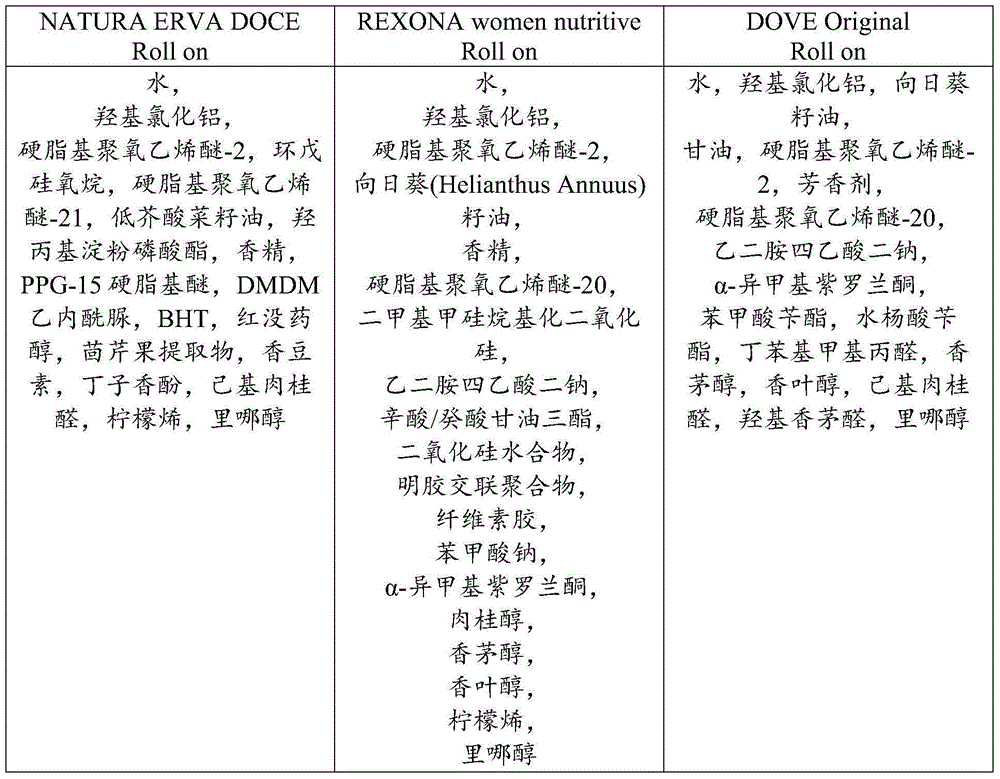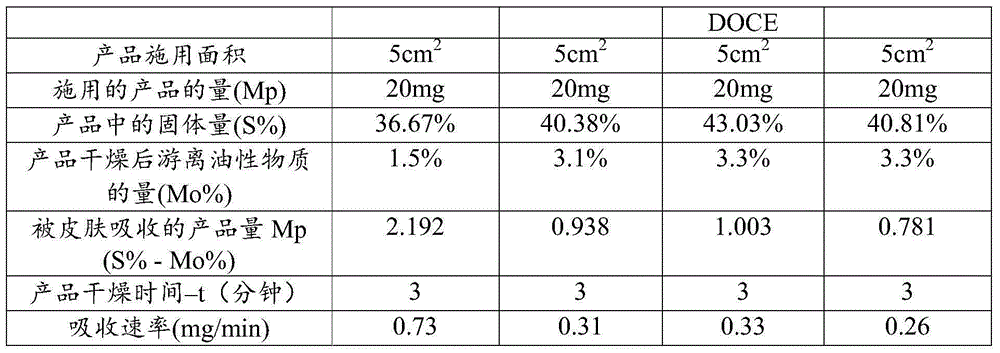Deodorant antiperspirant compositions
A composition and antiperspirant technology, applied in the directions of deodorization, cosmetic preparations, cosmetic preparations, etc., can solve problems such as stability problems, and achieve the effect of lasting effect and rapid absorption
- Summary
- Abstract
- Description
- Claims
- Application Information
AI Technical Summary
Problems solved by technology
Method used
Image
Examples
example 1
[0040] Using the ingredients in Table 1 below and the following procedure, a roll-on composition according to the present invention was prepared.
[0041] Table 1
[0042] Element
Features
weight%
A: water
54.3
B: Stearyl polyoxyethylene ether-2
Surfactant
3.00
C: Stearyl polyoxyethylene ether-21
Surfactant
1.00
D: PPG-15 stearyl ether
emollient
4.00
E: aluminum hydroxychloride (50%)
35.0
F: Aluminum starch octenyl succinate
absorbent
0.50
G: silica
absorbent
0.30
H: ethylhexylglycerin, caprylyl glycol
skin conditioner
1.0
I: polyglyceryl-3 caprylate
Emulsifier
0.30
skin conditioner
0.10
K: sodium benzoate
preservatives
0.50
[0043] program
[0044] 1. Oil Phase - Weigh D, B, C, I, H and J into a container and start heating to 75-80°C....
example 2
[0049] The absorption rate of the composition of Example 1 as a roll-on deodorant was determined along with three commercial products. Commercial products contain the following ingredients:
[0050]
[0051] Skin absorption is defined as the non-transfer retention of the oily substance by the skin when in contact with a substrate having a high affinity for the oily substance. Product absorption is determined by a combination of two techniques: measuring the amount of solids in the product in vitro under specified humidity and temperature conditions, simulating real conditions of product application on the skin and measuring the amount of solids on the skin after application and drying of the product. The amount of extrinsic free oily substance. The amount of product "absorbed" by the skin is calculated as the difference between the amount of solids initially applied to the skin and the amount of free extrinsic oily material on the skin. The results are shown in Table 2 be...
example 3
[0057] A study was carried out on the compositions of the invention to determine the 24, 48 and 72 hour deodorant effect (olfactory test) and the 72 hour antiperspirant effect.
[0058] After a 20-day rest period, draw 150 cm under the subject's armpit 2 of regions - randomly distributed. Compositions were prepared using the ingredients in Table 3 and the following procedure. The product was applied to one underarm, while the other side remained as a control (no product applied). Apply continuously for 3 days. Three days after application, subjects performed an armpit odor assessment at 24 hours and 48 hours after the third product application and 72 hours after the third product application and stayed in a dry hot in the room for 80 minutes to collect the sweat.
[0059] The rest period lasts 20 days. During this period, subjects were instructed to use only standard soap and a standard antibacterial deodorant provided by ALLERGISA, and not to use any other type of produc...
PUM
| Property | Measurement | Unit |
|---|---|---|
| specific surface area | aaaaa | aaaaa |
| diameter | aaaaa | aaaaa |
| particle size | aaaaa | aaaaa |
Abstract
Description
Claims
Application Information
 Login to View More
Login to View More - R&D
- Intellectual Property
- Life Sciences
- Materials
- Tech Scout
- Unparalleled Data Quality
- Higher Quality Content
- 60% Fewer Hallucinations
Browse by: Latest US Patents, China's latest patents, Technical Efficacy Thesaurus, Application Domain, Technology Topic, Popular Technical Reports.
© 2025 PatSnap. All rights reserved.Legal|Privacy policy|Modern Slavery Act Transparency Statement|Sitemap|About US| Contact US: help@patsnap.com



